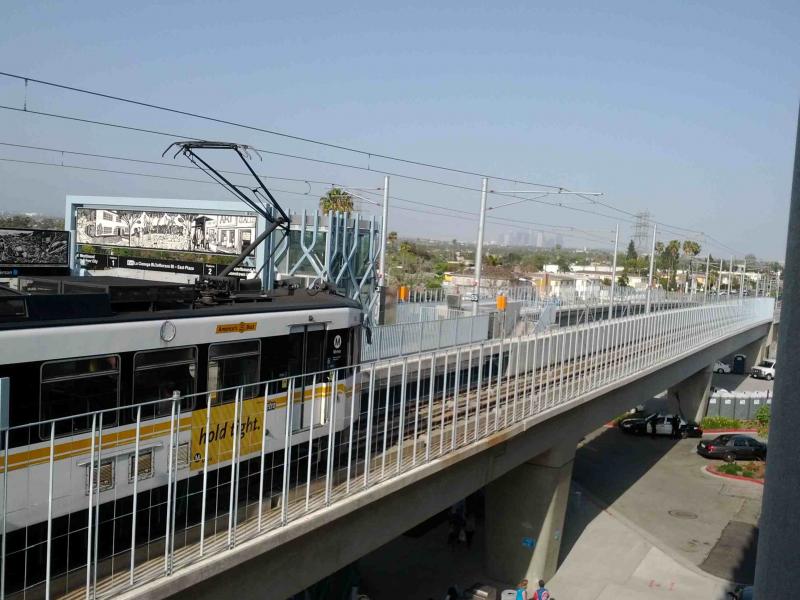Expo Line: Progress In Reverse

It was, of course, completely unlike Chicago.
The city's El train carves a path through the urban area’s dense core, is guarded by the skyscrapers and clacks along its hundred-year-old-tracks like a wooden roller coaster.
Instead he was gazing out the window at a 75 degree Sunday in late April, to the San Gabriel mountains and the spires of downtown LA that steadily came into view.
A bus driver who lived on the Westside explained how this line could take him right to the spot where his route begins. He'd driven there previously, and he didn't think the Expo Line would be any faster. But still, consider the options!
At nearly every stop along the way, passengers stepped out of the car to take photos with their phones. Of the Exposition Park Rose Garden. Of USC. Of a biker meet up on Flower St. Of the Staple Center.
At the terminus of the Expo Line at Seventh and Flower a man marched up to an MTA employee and proceeded to thank him.
It's hard to explain just why the Angelenos aboard this particular eastbound train were giddy about a 19th century urban technology-- a technology that has been in place in nearly every world-class city.
And as far as LA is concerned, it’s a technology that is hardly perfect.
The advertised 30 minutes from Culver City to downtown is no revelation; a traffic-free trip on the 10 is easily half that. The trains also have to stop at traffic lights all along the route and with each deflating stop you could see the passengers wince as memories of LA's bus routes and clogged surface streets coursed through them.
Is this just a glorified bus route?
An argument could easily be made for that, although I'm not sure I would want it another way. A subterranean expo line could be faster, and probably be safer, but it runs fundamentally against the LA ethos. Let the mole people New York and London confine themselves to their bunkers from unyielding weather.
The fully raised tracks of the aforementioned El fit into Chicago's vertical design, but here they would be another raised abrasion running through residential neighborhoods.
Calling the Expo Line--which ran hundreds of millions of dollars over budget, was behind schedule and, let it not go without saying, is still unfinished-- "perfect" would be a lie. But it is something. And in a city where something so often takes a backseat to nothing, it was unexpectedly refreshing.
Twenty years after the City of Los Angeles reached its absolute nadir in civic relationships, the exspectacular expo gives the smallest bit of hope.
In the late afternoon, I boarded a packed train heading back to Culver City. As the trains started moving west, passengers began chattering that the train was, unbelievably, moving backward. Coming from Northern California where BART passengers are experts at mass transit seating that faces away from a train's direction, it was a moment of pleasant, endearing ignorance.
There we were in Los Angeles, on a Westward train moving forward in reverse.



